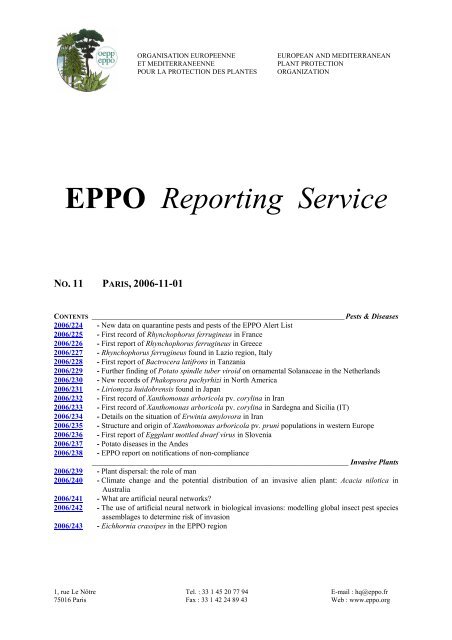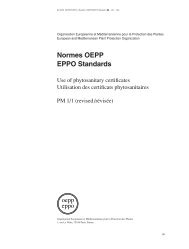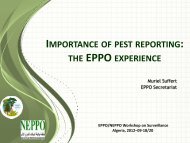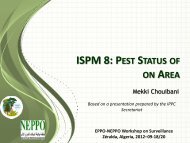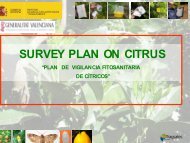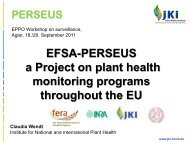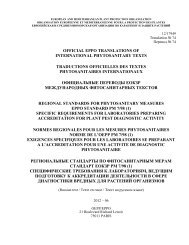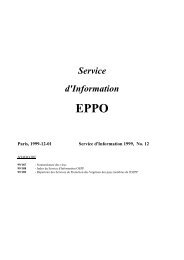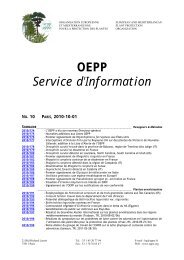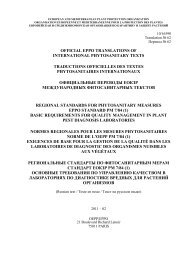EPPO Reporting Service - Lists of EPPO Standards - European and ...
EPPO Reporting Service - Lists of EPPO Standards - European and ...
EPPO Reporting Service - Lists of EPPO Standards - European and ...
You also want an ePaper? Increase the reach of your titles
YUMPU automatically turns print PDFs into web optimized ePapers that Google loves.
1, rue Le Nôtre<br />
75016 Paris<br />
ORGANISATION EUROPEENNE<br />
ET MEDITERRANEENNE<br />
POUR LA PROTECTION DES PLANTES<br />
Tel. : 33 1 45 20 77 94<br />
Fax : 33 1 42 24 89 43<br />
EUROPEAN AND MEDITERRANEAN<br />
PLANT PROTECTION<br />
ORGANIZATION<br />
<strong>EPPO</strong> <strong>Reporting</strong> <strong>Service</strong><br />
NO. 11 PARIS, 2006-11-01<br />
CONTENTS __________________________________________________________________Pests & Diseases<br />
2006/224 - New data on quarantine pests <strong>and</strong> pests <strong>of</strong> the <strong>EPPO</strong> Alert List<br />
2006/225 - First record <strong>of</strong> Rhynchophorus ferrugineus in France<br />
2006/226 - First report <strong>of</strong> Rhynchophorus ferrugineus in Greece<br />
2006/227 - Rhynchophorus ferrugineus found in Lazio region, Italy<br />
2006/228 - First report <strong>of</strong> Bactrocera latifrons in Tanzania<br />
2006/229 - Further finding <strong>of</strong> Potato spindle tuber viroid on ornamental Solanaceae in the Netherl<strong>and</strong>s<br />
2006/230 - New records <strong>of</strong> Phakopsora pachyrhizi in North America<br />
2006/231 - Liriomyza huidobrensis found in Japan<br />
2006/232 - First record <strong>of</strong> Xanthomonas arboricola pv. corylina in Iran<br />
2006/233 - First record <strong>of</strong> Xanthomonas arboricola pv. corylina in Sardegna <strong>and</strong> Sicilia (IT)<br />
2006/234 - Details on the situation <strong>of</strong> Erwinia amylovora in Iran<br />
2006/235 - Structure <strong>and</strong> origin <strong>of</strong> Xanthomonas arboricola pv. pruni populations in western Europe<br />
2006/236 - First report <strong>of</strong> Eggplant mottled dwarf virus in Slovenia<br />
2006/237 - Potato diseases in the Andes<br />
2006/238 - <strong>EPPO</strong> report on notifications <strong>of</strong> non-compliance<br />
CONTENTS ___________________________________________________________________ Invasive Plants<br />
2006/239 - Plant dispersal: the role <strong>of</strong> man<br />
2006/240 - Climate change <strong>and</strong> the potential distribution <strong>of</strong> an invasive alien plant: Acacia nilotica in<br />
Australia<br />
2006/241 - What are artificial neural networks?<br />
2006/242 - The use <strong>of</strong> artificial neural network in biological invasions: modelling global insect pest species<br />
assemblages to determine risk <strong>of</strong> invasion<br />
2006/243 - Eichhornia crassipes in the <strong>EPPO</strong> region<br />
E-mail : hq@eppo.fr<br />
Web : www.eppo.org
<strong>EPPO</strong> <strong>Reporting</strong> <strong>Service</strong><br />
2006/224 New data on quarantine pests <strong>and</strong> pests <strong>of</strong> the <strong>EPPO</strong> Alert List<br />
By browsing through the literature, the <strong>EPPO</strong> Secretariat has extracted the following new data<br />
concerning quarantine pests <strong>and</strong> pests included on the <strong>EPPO</strong> Alert List. The situation <strong>of</strong> the pest<br />
concerned is indicated in bold, using the terms <strong>of</strong> ISPM no. 8.<br />
• New records<br />
Xanthomonas axonopodis pv. vesicatoria (<strong>EPPO</strong> A2 list) was detected in the Republic <strong>of</strong><br />
Macedonia during surveys done in pepper crops (Capsicum annuum). Bacterial strains were<br />
characterized as belonging to type A, <strong>and</strong> were identified to races P0 <strong>and</strong> P2 (Mitrev <strong>and</strong><br />
Kovačević, 2006). The <strong>EPPO</strong> Secretariat had previously no data on the occurrence <strong>of</strong> this<br />
bacterium in Macedonia. Present, no detail.<br />
• Detailed records<br />
Surveys were done in autumn 2005 in Kosovo (RS) for the presence <strong>of</strong> fruit tree phytoplasmas.<br />
Symptoms resembling those <strong>of</strong> apple proliferation, pear decline <strong>and</strong> <strong>European</strong> stone fruit yellows<br />
were observed in all orchards studied. Samples were collected <strong>and</strong> tested. The presence <strong>of</strong><br />
‘C<strong>and</strong>idatus Phytoplasma mali’ (<strong>EPPO</strong> A2 list), ‘C<strong>and</strong>idatus Phytoplasma pyri’ (<strong>EPPO</strong> A2 list)<br />
was detected in 6 apple trees <strong>and</strong> 3 pear trees, respectively. ‘C<strong>and</strong>idatus Phytoplasma prunorum’<br />
was not detected. This is the first record <strong>of</strong> apple proliferation <strong>and</strong> pear decline in Kosovo (Myrta<br />
et al., 2006).<br />
During extensive surveys carried out in Bosnia <strong>and</strong> Herzegovina for stone fruit viruses in 2003,<br />
16 isolates <strong>of</strong> Plum pox virus (Potyvirus – <strong>EPPO</strong> A2 list) were typed. Isolates were collected<br />
from peach <strong>and</strong> plum, <strong>and</strong> from various parts <strong>of</strong> the country. 4 isolates were identified as PPV-M,<br />
8 as PPV-D, <strong>and</strong> 4 as natural D/M recombinants. This high variability <strong>of</strong> PPV isolates fits with<br />
the presence <strong>of</strong> this virus over a long period <strong>of</strong> time in Bosnia <strong>and</strong> Herzegovina (Matic et al.,<br />
2006).<br />
An outbreak <strong>of</strong> Ralstonia solanacearum (<strong>EPPO</strong> A2 list) was observed on tomato crops<br />
(Lycopersicon esculentum) in Nigeria. In June 1996, 80% <strong>of</strong> tomato fields in the production area<br />
<strong>of</strong> Ogun state presented wilt symptoms. Later surveys done in 1998 in Edo, Delta, Lagos, Oyo<br />
<strong>and</strong> Osun states showed that 60-80% <strong>of</strong> the tomato fields were infected. Laboratory studies<br />
showed that all collected isolates belonged to R. solanacearum biovar 3. According to the<br />
authors, this is the first report <strong>of</strong> R. solanacearum biovar 3 in Nigeria (Adebayo <strong>and</strong> Epko, 2005).<br />
Tomato yellow leaf curl virus (Begomovirus, TYLCV – <strong>EPPO</strong> A2 list) is reported for the first<br />
time in Sardegna, Italy. In addition to Tomato yellow leaf curl Sardinia virus (TYLCSV),<br />
TYLCV was detected during recent surveys conducted in tomato glasshouses in the province <strong>of</strong><br />
Cagliari (Nannini et al., 2005).<br />
Pests & Diseases 2
<strong>EPPO</strong> <strong>Reporting</strong> <strong>Service</strong><br />
Venturia nashicola (EU Annexes) is an economically important disease on pears (Pyrus<br />
bretschneideri) in China. It occurs at least in the Sh<strong>and</strong>ong <strong>and</strong> Shanxi provinces (Lian et al.,<br />
2006).<br />
Xylella fastidiosa (<strong>EPPO</strong> A1 list) is reported for the first time from Oklahoma (US). An elm tree<br />
(Ulmus americana) located in a botanical garden showed symptoms <strong>of</strong> leaf scorch in summer<br />
2004, <strong>and</strong> molecular studies confirmed the presence <strong>of</strong> the bacterium (Olson et al., 2006).<br />
• New host plants<br />
Rhamnus purshiana (Rhamnaceae), Crataegus douglasii <strong>and</strong> Prunus laurocerasus (both<br />
Rosaceae) have been identified as new hosts <strong>of</strong> Rhagoletis indifferens (Diptera: Tephritidae –<br />
<strong>EPPO</strong> A1 list) in Washington state, USA (Yee <strong>and</strong> Goughnour, 2005).<br />
In Pol<strong>and</strong>, Tomato black ring virus (Nepovirus – EU Annexes) was identified in courgettes<br />
(Cucurbita pepo var. giromantiina). Affected plants showed leaf mosaic <strong>and</strong> fruit deformation<br />
(Pospieszny <strong>and</strong> Borodynko, 2005).<br />
Source: Adebayo OS, Ekpo JA (2005) Biovar <strong>of</strong> Ralstonia solanacearum causing bacterial wilt <strong>of</strong><br />
tomato in Nigeria. Plant Disease 89(10), p1129.<br />
Lian S, Li BH, Xu XM (2006) Formation <strong>and</strong> development <strong>of</strong> pseudothecia <strong>of</strong> Venturia<br />
nashicola. Journal <strong>of</strong> Phytopathology 154(2), 119-124.<br />
Matic S, Al-Rwahnih M, Myrta A (2006) Diversity <strong>of</strong> Plum pox virus isolates in Bosnia <strong>and</strong><br />
Herzegovina. Plant Pathology 55(1), 11-17.<br />
Mitrev S, Kovačević B (2006) Characterization <strong>of</strong> Xanthomonas axonopodis pv. vesicatoria<br />
isolated from peppers in Macedonia. Journal <strong>of</strong> Plant Pathology 88(3), 321-324.<br />
Myrta A, Martini M, Susuri L, Susuri HS, Carraro L (2006) First report <strong>of</strong> apple proliferation<br />
<strong>and</strong> pear decline phytoplasmas in Kosovo. Journal <strong>of</strong> Plant Pathology 88(1), 121-125.<br />
Nannini M, Testa M, Napoli C, Accotto GP (2005) [First report <strong>of</strong> Tomato yellow leaf curl<br />
virus (TYLCV) in Sardinia.] Informatore Fitopatologico 6, 53-56 (in Italian).<br />
Olson BR, Dominiak J, von Broembsen S, Berg M, Bextine BR (2006) First report <strong>of</strong> Xylella<br />
fastidiosa in Oklahoma. Plant Disease 90(1), p 108.<br />
Pospieszny H, Borodynko N (2005) First report <strong>of</strong> Tomato black ring virus (TBRV) in the<br />
natural infection <strong>of</strong> zucchini (Cucurbita pepo L. convar giromantiina) in Pol<strong>and</strong>. Journal <strong>of</strong><br />
Plant Protection Research 45(4), 321-325.<br />
Yee WL, Goughnour RB (2005) New hosts <strong>of</strong> western cherry fruit fly, Rhagoletis indifferens<br />
(Diptera: Tephritidae), <strong>and</strong> their relationship to life history characteristics <strong>of</strong> this fly. Annals<br />
<strong>of</strong> the Entomological Society <strong>of</strong> America 98(5), 703-710.<br />
Additional key words: new records, detailed records,<br />
new host plants<br />
Computer codes: ACIZJA, PHYPMA, PHYPPY,<br />
PPV000, PSDMSO, RHAGIN, TBRV00, TYLCV0,<br />
VENTNA, XANTAV, XYLEFA, BA, CN, IT, IT, MK,<br />
NG, PL, US, YU<br />
Pests & Diseases 3
<strong>EPPO</strong> <strong>Reporting</strong> <strong>Service</strong><br />
2006/225 First record <strong>of</strong> Rhynchophorus ferrugineus in France<br />
The NPPO <strong>of</strong> France recently informed the <strong>EPPO</strong> Secretariat <strong>of</strong> the first finding <strong>of</strong><br />
Rhynchophorus ferrugineus (Coleoptera: Curculionidae - <strong>EPPO</strong> A2 list) on its territory. On 2006-<br />
09-12, 4 larvae collected from a Phoenix canariensis were identified <strong>and</strong> confirmed as being R.<br />
ferrugineus. The infested palm trees (10 m tall) were located in a private garden at Porto-<br />
Vecchio, in the south <strong>of</strong> Corsica.<br />
A surveillance programme using traps had been initiated earlier in 2006 in several volunteer<br />
nurseries located in the departments <strong>of</strong> Var <strong>and</strong> Alpes-Maritimes (region Provence-Alpes-Côte<br />
d’Azur). In the deparment <strong>of</strong> Var, an adult beetle was caught on 2006-10-20 in 1 nursery at<br />
Grimaud on different palm species which had been imported from Italy, Spain, Brazil <strong>and</strong> Egypt.<br />
However, as <strong>of</strong> 2006-11-17, no infested palm could be identified despite all inspections made.<br />
Three other cases were then reported from Var:<br />
- 2 females were identified on 2006-10-24 on a P. canariensis, which had been planted in 1996 in<br />
a private garden at Sanary-sur-Mer. The tree was growing in urban environment but in the<br />
vicinity <strong>of</strong> a nursery.<br />
- 1 outbreak was identified on 2006-11-15 in a nursery at Sainte-Maxime, on an imported lot <strong>of</strong><br />
P. canariensis (arrived in September 2006 from Italy).<br />
- 1 outbreak was found on 2006-11-16 at a public park <strong>of</strong> La Croix Valmer, in 1 P. canariensis<br />
which had been planted in 1980.<br />
Finally, in the Alpes-Maritimes department, an adult was caught on the 2006-11-21 at Saint-<br />
Martin-du-Var, in a nursery growing different palm species.<br />
For all 6 outbreaks, surveys are being carried out <strong>and</strong> traps have been installed to determine the<br />
extent <strong>of</strong> the infestation. All palms trees identified as being infested by R. ferrugineus will be<br />
destroyed.<br />
The situation <strong>of</strong> Rhynchophorus ferrugineus in France can be described as follows: Present, first<br />
recorded in 2006, few outbreaks found in the departments <strong>of</strong> Corse du Sud (1), Var (4) <strong>and</strong><br />
Alpes-Maritimes (1), under eradication.<br />
Source: NPPO <strong>of</strong> France, 2006-11.<br />
Additional key words: new record Computer codes: RHYCFE, FR<br />
Pests & Diseases 4
<strong>EPPO</strong> <strong>Reporting</strong> <strong>Service</strong><br />
2006/226 First report <strong>of</strong> Rhynchophorus ferrugineus in Greece<br />
The NPPO <strong>of</strong> Greece recently informed the <strong>EPPO</strong> Secretariat about the presence <strong>of</strong><br />
Rhynchophorus ferrugineus (Coleoptera: Curculionidae - <strong>EPPO</strong> A2 list) on its territory. The pest<br />
was found on the isl<strong>and</strong>s <strong>of</strong> Kriti (Iraklio prefecture) <strong>and</strong> Rhodos. Phytosanitary measures are<br />
being taken to prevent any further spread.<br />
The situation <strong>of</strong> Rhynchophorus ferrugineus in Greece can be described as follows: Present,<br />
reported in 2006 on the isl<strong>and</strong>s <strong>of</strong> Kriti <strong>and</strong> Rhodos, under <strong>of</strong>ficial control.<br />
Source: NPPO <strong>of</strong> Greece, 2006-12.<br />
Additional key words: new record Computer codes: RHYCFE, GR<br />
2006/227 Rhynchophorus ferrugineus found in Lazio region, Italy<br />
The NPPO <strong>of</strong> Italy recently informed the <strong>EPPO</strong> Secretariat <strong>of</strong> the presence <strong>of</strong> Rhynchophorus<br />
ferrugineus (Coleoptera: Curculionidae – <strong>EPPO</strong> A2 list) in the Lazio region, Italy. The pest was<br />
found on ornamental palms in several municipalities in the province <strong>of</strong> Latina, as well as in a few<br />
private gardens in Roma. Eradication measures are being taken in the Lazio region.<br />
The situation <strong>of</strong> Rhynchophorus ferrugineus in Italy can be described as follows: Present, few<br />
outbreaks found in Campania, Lazio, Toscana <strong>and</strong> Sicilia, under <strong>of</strong>ficial control.<br />
Source: NPPO <strong>of</strong> Italy, 2006-11.<br />
Additional key words: detailed record Computer codes: RHYCFE, IT<br />
2006/228 First report <strong>of</strong> Bactrocera latifrons in Tanzania<br />
The presence <strong>of</strong> Bactrocera latifrons (Diptera: Tephritidae – EU Annexes) is reported for the<br />
first time in Tanzania. This is also the first record for Africa. In May 2006, 2 female specimens<br />
were caught in a protein bait trap at Morogoro, Tanzania. The trap had been placed in a citrus<br />
tree but aubergines (Solanum aethiopica) were grown in the near vicinity. B. latifrons is a fruit<br />
fly species <strong>of</strong> Asian origin which mainly attacks solanaceous crops (e.g. aubergines <strong>and</strong><br />
tomatoes). Its currently known distribution is as follows:<br />
Asia: Brunei Darussalam, China, India, Laos, Malaysia, Pakistan, Singapore, Sri Lanka, Taiwan,<br />
Thail<strong>and</strong>, Vietnam.<br />
Africa: Tanzania.<br />
America: USA (Hawaii only).<br />
Pests & Diseases 5
<strong>EPPO</strong> <strong>Reporting</strong> <strong>Service</strong><br />
Source: Tephritid Workers Database<br />
Alert! New invasive Bactrocera species in Africa : Bactrocera latifrons (dated<br />
2006-10-13). http://www.tephritid.org/twd/srv/en/home<br />
Additional key words: new record Computer codes: DACULA, TZ<br />
2006/229 Further finding <strong>of</strong> Potato spindle tuber viroid on ornamental Solanaceae in the<br />
Netherl<strong>and</strong>s<br />
An isolated finding <strong>of</strong> Potato spindle tuber viroid (Pospiviroid, PSTVd – <strong>EPPO</strong> A2 list) had<br />
previously been reported in the Netherl<strong>and</strong>s on the ornamental Solanum jasminoides (<strong>EPPO</strong> RS<br />
2006/142) <strong>and</strong> followed by a similar report in Germany (<strong>EPPO</strong> RS 2006/159). The NPPO <strong>of</strong> the<br />
Netherl<strong>and</strong>s recently informed the <strong>EPPO</strong> Secretariat <strong>of</strong> further findings <strong>of</strong> PSTVd infections on<br />
the premises <strong>of</strong> several companies growing ornamental Solanaceae. These infections were<br />
discovered as part <strong>of</strong> a specific monitoring survey for viroids on symptomless ornamental plants.<br />
This survey was triggered by earlier outbreaks <strong>of</strong> PSTVd <strong>and</strong> other pospiviroids detected in<br />
Europe (the later mainly found on tomato crops) for which no source <strong>of</strong> infestation could be<br />
identified. Specific surveys have confirmed that PSTVd did not occur in the Netherl<strong>and</strong>s on<br />
potato or tomato crops. The first PSTVd finding which was made in July 2006 on Solanum<br />
jasminoides (<strong>EPPO</strong> RS 2006/142) is now considered eradicated. Another outbreak was found in<br />
November 2006 on symptomless ornamental plants <strong>of</strong> Solanum jasminoides <strong>and</strong> several<br />
Brugmansia species (B. suavolens, B. x c<strong>and</strong>ida, B. cordata <strong>and</strong> B. variegata). Infections were<br />
detected on the premises <strong>of</strong> several companies producing potted plants for final consumers <strong>and</strong> in<br />
one propagation company producing Brugmansia plants. So far, no impact <strong>of</strong> PSTVd has been<br />
observed on these ornamental species which all remained symptomless. During trace-back<br />
studies, eight consignees located in other EU member states <strong>and</strong> which may have received<br />
possibly contaminated plants in 2005/2006 were informed. In the Netherl<strong>and</strong>s, eradication<br />
measures are being applied. The origin <strong>of</strong> these PSTVd infections remains unclear.<br />
The pest status <strong>of</strong> Potato spindle tuber viroid in the Netherl<strong>and</strong>s is <strong>of</strong>ficially declared as follows:<br />
Transient, only on ornamental plants <strong>of</strong> Solanum jasminoides <strong>and</strong> Brugmansia spp., under<br />
eradication.<br />
Source: NPPO <strong>of</strong> the Netherl<strong>and</strong>s, 2006-11.<br />
Additional key words: detailed record Computer codes: PSTVD0, NL<br />
Pests & Diseases 6
<strong>EPPO</strong> <strong>Reporting</strong> <strong>Service</strong><br />
2006/230 New records <strong>of</strong> Phakopsora pachyrhizi in North America<br />
Soybean rust caused by Phakopsora pachyrhizi (<strong>EPPO</strong> Alert List) has continued to spread in<br />
North America.<br />
Mexico<br />
At the end <strong>of</strong> October 2005, soybean leaves (Glycine max cv. ‘Huasteca 400’) showing rust<br />
symptoms were collected in Tamuin (State <strong>of</strong> San Luis Potosi) <strong>and</strong> in Altamira (Tamaulipas).<br />
The presence <strong>of</strong> Phakopsora pachyrhizi was then confirmed by laboratory tests. This was the first<br />
report <strong>of</strong> P. pachyrhizi in Mexico. In 2006, another outbreak <strong>of</strong> soybean rust was reported near<br />
the city <strong>of</strong> Tampico (Tamaulipas).<br />
USA<br />
In 2006, P. pachyrhizi was recorded in the 15 following states: Alabama, Arkansas, Florida,<br />
Georgia, Illinois*, Indiana*, Kentucky*, Louisiana, Mississippi, Missouri, North Carolina, South<br />
Carolina*, Tennessee, Texas*, Virginia*.<br />
__________<br />
* New detailed records<br />
Source: NAPPO Pest Alert System - Official Pest Reports. Detection <strong>of</strong> soybean rust<br />
(Phakopsora pachyrhizi) in the states <strong>of</strong> Tamaulipas <strong>and</strong> San Luis Potosi,<br />
Mexico. http://www.pestalert.org/oprDetail_print.cfm?oprid=192<br />
ProMed posting <strong>of</strong> 2006-05-25. Soybean rust – Mexico (02).<br />
http://www.promedmail.org<br />
USDA website – Soybean rust information site. http://www.sbrusa.net/<br />
Additional key words: new record, detailed records Computer codes: PHAKPA, MX, US<br />
2006/231 Liriomyza huidobrensis found in Japan<br />
In Japan, Liriomyza huidobrensis (Diptera: Agromyzidae – <strong>EPPO</strong> A2 list) was found for the first<br />
time in Aomori Prefecture (north <strong>of</strong> Honshu) in July 2004, on various glasshouse crops. Studies<br />
done on specimens collected from Hokkaido <strong>and</strong> Honshu (Aomori, Miyagi <strong>and</strong> Yamaguchi<br />
Prefectures) showed that the Japanese specimens (as those obtained from China, Korea <strong>and</strong><br />
Taiwan) belonged to the South American clade. The <strong>EPPO</strong> Secretariat had previously no data on<br />
Pests & Diseases 7
<strong>EPPO</strong> <strong>Reporting</strong> <strong>Service</strong><br />
the occurrence <strong>of</strong> L. huidobrensis in Japan. L. huidobrensis had been intercepted on<br />
consignments imported into Japan but not reported on Japanese crops, so far.<br />
The situation <strong>of</strong> Liriomyza huidobrensis in Japan can be described as follows: Present, first<br />
reported in 2004, found in protected crops in Honshu (north) <strong>and</strong> Hokkaido.<br />
Source: Shindo J, Kinota M, Inokuchi S, Kimura Y, Fujimura T (2005) Occurrence <strong>of</strong><br />
pea leafminer, Liriomyza huidobrensis (Blanchard) (Diptera: Agromyzidae), in<br />
Aomori Prefecture. Annual Report <strong>of</strong> the Society <strong>of</strong> Plant Protection <strong>of</strong> North<br />
Japan 55, 236-239 (abst.).<br />
Available on-line: http://njp.ac.affrc.go.jp/abstract/html/56/56-145.html<br />
Takano SI, Iwaizumi R, Nakanishi Y, Someya H, Iwasaki A (2005) [Genetic<br />
differentiation <strong>and</strong> morphological comparison between two clades <strong>of</strong><br />
Liriomyza huidobrensis (Blanchard) (Diptera: Agromyzidae).]. Research<br />
Bulletin <strong>of</strong> the Plant Protection <strong>Service</strong>, Japan 41, 43-46 (in Japanese).<br />
Additional key words: new record Computer codes: LIRIHU, JP<br />
2006/232 First record <strong>of</strong> Xanthomonas arboricola pv. corylina in Iran<br />
In Iran, a severe disease <strong>of</strong> hazelnut (Corylus avellana) was observed in 2004 in several orchards<br />
<strong>of</strong> the Gilan province (north-west, along the Caspian Sea). Water-soaked spots were observed on<br />
leaves which then desiccated. Shoots also presented dark-brown to black necrotic lesions.<br />
Analysis <strong>of</strong> extracts from symptomatic tissues revealed the presence <strong>of</strong> Xanthomonas arboricola<br />
pv. corylina (<strong>EPPO</strong> A2 list). This pathogen could then be inoculated to healthy hazelnut plants<br />
<strong>and</strong> re-isolated from lesions which appeared on these inoculated plants. This is the first report <strong>of</strong><br />
X. arboricola pv. corylina in Iran.<br />
The situation <strong>of</strong> Xanthomonas arboricola pv. corylina in Iran can be described as follows:<br />
Present, first observed in 2004, in the Gilan province (north-west).<br />
Source: Kazempour MN, Ali B, Elahinia SA (2006) First report <strong>of</strong> bacterial blight <strong>of</strong><br />
hazelnut caused by Xanthomonas arboricola pv. corylina in Iran. Journal <strong>of</strong><br />
Plant Pathology 88(3), p 341.<br />
Additional key words: new record Computer codes: XANTCY, IR<br />
Pests & Diseases 8
<strong>EPPO</strong> <strong>Reporting</strong> <strong>Service</strong><br />
2006/233 First record <strong>of</strong> Xanthomonas arboricola pv. corylina in Sardegna <strong>and</strong> Sicilia (IT)<br />
In Italy, during surveys done in hazelnut (Corylus avellana) orchards in Sardegna (near Nuoro),<br />
<strong>and</strong> Sicilia (near Messina <strong>and</strong> Catania), symptoms resembling those <strong>of</strong> Xanthomonas arboricola<br />
pv. corylina (<strong>EPPO</strong> A2 list) were observed. Water-soaked necrotic spots were observed on fruit<br />
husks <strong>and</strong> twigs sometimes showed partial die-back. Laboratory <strong>and</strong> pathogenicity tests<br />
confirmed that Xanthomonas arboricola pv. corylina was the causal agent <strong>of</strong> the disease<br />
observed. This is the first record <strong>of</strong> X. arboricola pv. corylina on both isl<strong>and</strong>s. In Italy, X.<br />
arboricola pv. corylina had been reported previously in Lazio (<strong>EPPO</strong> RS 519/12, 1992).<br />
The situation <strong>of</strong> Xanthomonas arboricola pv. corylina in Italy can be described as follows:<br />
Present, occurs in Lazio <strong>and</strong> reported in 2006 in Sardegna <strong>and</strong> Sicilia.<br />
Source: Cirvilleri G, Fiori M, Bonaccorsi A, Scuderi G, Virdis S, Scortichini M (2006)<br />
Occurrence <strong>of</strong> Xanthomonas arboricola pv. corylina in hazelnut orchards in<br />
Sardinia <strong>and</strong> Sicily. Journal <strong>of</strong> Plant Pathology 88(3), p 340.<br />
Additional key words: detailed record Computer codes: XANTCY, IT<br />
2006/234 Details on the situation <strong>of</strong> Erwinia amylovora in Iran<br />
In Iran, Erwinia amylovora (<strong>EPPO</strong> A2 list) was reported for the first time in 1991 on pear trees in<br />
Karaj (Tehran province), <strong>and</strong> then found in many orchards in the provinces <strong>of</strong> Azarbaijan,<br />
Ghazvin <strong>and</strong> Maz<strong>and</strong>aran. During a survey <strong>of</strong> pear orchards in different areas <strong>of</strong> the province <strong>of</strong><br />
Gilan, symptoms <strong>of</strong> necrotic shoots <strong>and</strong> bacterial exudates were observed in pear trees. Based on<br />
morphological, biochemical <strong>and</strong> physiological characters, as well as PCR, most bacterial isolates<br />
were identified as E. amylovora.<br />
The situation <strong>of</strong> Erwinia amylovora in Iran can be described as follows: Present, first reported<br />
in 1991, found in the north (provinces <strong>of</strong> Azarbaijan, Ghazvin, Gilan, Maz<strong>and</strong>aran,<br />
Tehran).<br />
Source: Kazempour MN, Kamran E, Ali B (2006) Erwinia amylovora causing<br />
fireblight or pear in the Guilan province <strong>of</strong> Iran. Journal <strong>of</strong> Plant Pathology<br />
88(1), 113-116.<br />
Additional key words: detailed record Computer codes: ERWIAM, IR<br />
Pests & Diseases 9
<strong>EPPO</strong> <strong>Reporting</strong> <strong>Service</strong><br />
2006/235 Structure <strong>and</strong> origin <strong>of</strong> Xanthomonas arboricola pv. pruni populations in<br />
western Europe<br />
Xanthomonas arboricola pv. pruni (<strong>EPPO</strong> A2 list) was first described in North America in 1903.<br />
In Europe, it was first recorded in Italy in 1920. In France, the disease was observed in the 1990s<br />
in the southeast departments <strong>of</strong> Drôme <strong>and</strong> Gard (see <strong>EPPO</strong> RS 97/112). The disease was severe<br />
in 2000 <strong>and</strong> has continued to exp<strong>and</strong> to new stone fruit orchards. Studies were done in France on<br />
the population genetics <strong>of</strong> X. arboricola pv. pruni to analyse its variability <strong>and</strong> better underst<strong>and</strong><br />
its origin. Strains from the USA, Italy, France (as well as a limited number <strong>of</strong> strains from<br />
Australia, Brazil, New Zeal<strong>and</strong> <strong>and</strong> Uruguay) were studied using 3 complementary genomic tools<br />
(ITS region, 4 genes, FAFLP analysis). Results showed that population diversity was higher in<br />
the USA than in Italy <strong>and</strong> France. The same bacterial genotype was detected from 5 countries <strong>and</strong><br />
3 continents, a geographic distribution that can be explained by a human-aided migration <strong>of</strong> the<br />
pathogen. All data obtained supported the hypothesis that the pathogen originates from the USA<br />
<strong>and</strong> has subsequently been disseminated to Europe. In addition, it seemed more likely that X.<br />
arboricola pv. pruni was introduced to France via Italy.<br />
Source: Boudon S, Manceau C, Nottéghem JL (2006) Structure <strong>and</strong> origin <strong>of</strong><br />
Xanthomonas arboricola pv. pruni causing bacterial spot <strong>of</strong> stone fruit trees in<br />
western Europe. Phytopathology 95(9), 1081-1088.<br />
Additional key words: genetics Computer codes: XANTPR<br />
2006/236 First report <strong>of</strong> Eggplant mottled dwarf virus in Slovenia<br />
The NPPO <strong>of</strong> Slovenia informed the <strong>EPPO</strong> Secretariat that Eggplant mottled dwarf virus<br />
(Nucleorhabdovirus - EMDV) was found for the first time in 2003. EMDV was detected on<br />
tomato plants (Lycopersicon esculentum cv. Belle) showing unusual symptoms <strong>of</strong> chlorotic spots<br />
<strong>and</strong> wrinkles on Fruit, narrow <strong>and</strong> necrotic leaves. In June 2004, EMDV was also detected in<br />
potato crops (Solanum tuberosum cvs. Bistra, Désirée, Discovery, KIS94-1/5-14, Pšata). Infected<br />
plants showed severe dwarfing, leaf curling, reduced leaf size, small tubers produced in low<br />
numbers. Brown spots were clearly visible in cross sections <strong>of</strong> tubers. All infected plants were<br />
destroyed to prevent any further spread <strong>of</strong> the virus. In 2005, no further findings were made, <strong>and</strong><br />
the NPPO <strong>of</strong> Slovenia now considers that EMDV is no longer present on its territory.<br />
<strong>EPPO</strong> note: EMDV was first described in Italy on aubergine (S. melongena) in 1969 <strong>and</strong> occurs<br />
in many countries around the Mediterranean Basin. It has been recorded on vegetable crops,<br />
ornamental plants (Hibiscus rosa-sinensis, Lonicera, Pittosporum) <strong>and</strong> weeds (Solanum nigrum).<br />
On vegetable crops, EMDV has mainly been found on Solanaceae such as: Capsicum annuum<br />
Pests & Diseases 10
<strong>EPPO</strong> <strong>Reporting</strong> <strong>Service</strong><br />
(pepper), Nicotiana tabacum (tobacco), Lycopersicon esculentum (tomato), Solanum melongena<br />
(aubergine), Solanum tuberosum (potato); <strong>and</strong> on Curcurbitaceae such as: Cucumis sativus<br />
(cucumber) <strong>and</strong> Cucumis melo (melon). The economic impact <strong>of</strong> EMDV is considered to be<br />
minor because the incidence <strong>of</strong> field infection is usually very low. In vegetatively propagated<br />
crops, EMDV can be disseminated through infected propagating material. In the field, the<br />
distribution pattern <strong>of</strong> infected plants suggests transmission by aerial vectors <strong>of</strong> low efficiency.<br />
So far, one leafhopper species Agallia vorobjevi (Homoptera: Cicadellidae) has been shown to<br />
transmit the virus.<br />
The currently known distribution <strong>of</strong> EMDV is the following:<br />
<strong>EPPO</strong> region: Algeria, Bulgaria, Croatia, Greece, Israel, Italy, Jordan, Morocco, Portugal, Spain<br />
(Islas Canarias, <strong>and</strong> found in 2005 on the mainl<strong>and</strong>), Tunisia, Turkey.<br />
Africa: Algeria, Libya, Morocco, Tunisia.<br />
Asia: Afghanistan, Israel, Iran, Jordan, Turkey.<br />
Source: NPPO <strong>of</strong> Slovenia, 2006-05.<br />
Mavrič I, Tušek Žnidarič M, Viršček Marn M, Dolničar P, Mehle N, Lesemann<br />
DE, Ravnikar M (2006) First report <strong>of</strong> Eggplant mottled dwarf virus in potato<br />
<strong>and</strong> tomato in Slovenia. New Disease Reports.<br />
http://www.bspp.org.uk/ndr/july2006/2006-09.asp<br />
Other useful references:<br />
Aramburu J, Galipienso L, Tornos T, Matas M (2006) First report <strong>of</strong> Eggplant mottled dwarf<br />
virus in mainl<strong>and</strong> Spain. New Disease Reports. http://www.bspp.org.uk/ndr/jan2006/2006-<br />
03.asp<br />
Babaie GH, Izadpanah K (2003) Vector transmission <strong>of</strong> eggplant mottle dwarf virus in Iran.<br />
Journal <strong>of</strong> Phytopathology 151, 679-682.<br />
Chatzivassiliou EK, Efthimiou K, Drossos E, Papadopoulou A, Poimenidis G, Katis NI, (2004)<br />
A survey <strong>of</strong> tobacco viruses in tobacco crops <strong>and</strong> native flora in Greece. <strong>European</strong> Journal<br />
<strong>of</strong> Plant Pathology 110, 1011-1023.<br />
Cherif C, Martelli GP (1985) Outbreaks <strong>and</strong> new records. Tunisia. Mottled dwarf <strong>of</strong> eggplant.<br />
FAO Plant Protection Bulletin 33(4), 166-167.<br />
Ciuffo M, Roggero P, Masenga V, Stravato VM (1999) Natural infection <strong>of</strong> muskmelon by<br />
eggplant mottled dwarf rhabdovirus in Italy. Plant Disease 83(1), p 78.<br />
Katis NI, Chatzivassiliou EK, Clay C, Avgelis I, Manoussopoulos I, Lecoq H (2000)<br />
Occurrence <strong>of</strong> eggplant mottled dwarf nucleorhabdovirus (EMDV) in tobacco <strong>and</strong><br />
cucumber crops in Greece. Phytopatologia Mediterranea 39(2), p 319<br />
Kostova D, Masenga V, Milne RG, Lisa V (2001) First report <strong>of</strong> Eggplant mottled dwarf virus<br />
in cucumber <strong>and</strong> pepper in Bulgaria. New Disease Reports.<br />
http://www.bspp.org.uk/ndr/jul2001/2001-30.asp<br />
Martelli GP, Cherif C (1987) Eggplant mottle dwarf virus associated with vein yellowing <strong>of</strong><br />
honeysuckle. Journal <strong>of</strong> Phytopathology 119(1), 32-41.<br />
Martelli GP, Hamadi A (1986) Occurrence <strong>of</strong> eggplant mottle dwarf virus in Algeria. Plant<br />
Pathology 35(4), 595-597.<br />
Additional key words: new record Computer codes: EMDV00, SI<br />
Pests & Diseases 11
2006/237 Potato diseases in the Andes<br />
<strong>EPPO</strong> <strong>Reporting</strong> <strong>Service</strong><br />
In the Andes, it is considered that the status <strong>of</strong> fungal <strong>and</strong> bacterial diseases has not changed<br />
much during the last 10 to 15 years but that the situation <strong>of</strong> viruses has been substantially<br />
modified. The following points can be noted:<br />
Phytophthora infestans: outbreaks <strong>of</strong> mating type A2 <strong>of</strong> potato late blight have been observed in<br />
Bolivia. In the Andes, A2 mating type is reported only in Bolivia (in South America, it is also<br />
reported in non-Andean countries such as Brazil <strong>and</strong> Argentina). It is considered that the<br />
emergence <strong>of</strong> the A2 mating type is the result <strong>of</strong> seed movements from the Northern hemisphere.<br />
Ralstonia solanacearum (<strong>EPPO</strong> A2 list): bacterial wilt was the most important bacterial disease<br />
spreading in the Andes during the last 10 years. Biovars 1, 2A <strong>and</strong> 2T occur throughout Peru;<br />
only biovars 1 <strong>and</strong> 2A were found in Bolivia.<br />
Streptomyces scabies: a high incidence <strong>of</strong> common scab was observed in some localities in<br />
Bolivia (incidence <strong>of</strong> 30 to 40%, with up to 20% yield losses).<br />
PVY NTN : isolates <strong>of</strong> Potato virus Y (Potyvirus) causing tuber necrosis have been found in some<br />
countries, including Peru. Studies suggest that these isolates have always been present in the<br />
Andes <strong>and</strong> were probably spread with other potato viruses when the crop was introduced into<br />
Europe during the XVI century.<br />
Two new uncharacterized potato viruses: SB26/29 <strong>and</strong> SB41<br />
SB26/29 can cause severe symptoms such as mosaic, foliage deformation, dwarfing <strong>and</strong> severe<br />
growth reduction. Yield reductions varying from 30% to 80% according to the potato cultivar<br />
have been observed. This virus is spreading in Peru, <strong>and</strong> has been shown to be transmitted by a<br />
psyllid vector (Russelliana solanicola, Homoptera: Psyllidae). Isometric viral particles have been<br />
observed, but so far the virus could not be purified.<br />
SB41 can cause severe mosaic on potato. In experiments, it could be transmitted only by grafting<br />
<strong>and</strong> could also infect tomato (severe mosaic <strong>and</strong> deformation).<br />
Potato yellowing virus (tentative Alfamovirus): it is commonly observed in the Andes, causing<br />
systemic yellowing <strong>of</strong> the foliage. It is transmitted in a semi-persistent manner by aphids <strong>and</strong><br />
potato true seeds (on which it can cause a necrosis).<br />
Pepino mosaic virus (Potexvirus, PepMV – <strong>EPPO</strong> Alert List): PepMV has been found in some<br />
potato germplasm accessions growing in the field. So far, PepMV had only been reported from<br />
pepino (Solanum muricatum) <strong>and</strong> tomato (Lycopersicon esculentum) along the coast in Peru. Due<br />
to difficulties in isolating PepMV, the potato isolates could not be characterized.<br />
Pests & Diseases 12
<strong>EPPO</strong> <strong>Reporting</strong> <strong>Service</strong><br />
Papaya mosaic virus (Potexvirus, PapMV): this virus was also found in some potato germplasm<br />
accessions. This was not found surprising because PapMV occurs in Ullucus tuberosus which is a<br />
tuber crop widely grown in the Andes in the vicinity <strong>of</strong> potatoes.<br />
Potato yellow vein virus (tentative Crinivirus, PYVV): PYVV has spread during the last 7 to 10<br />
years from Colombia <strong>and</strong> Ecuador to Venezuela <strong>and</strong> Peru, respectively. It is transmitted by<br />
Trialeurodes vaporariorum <strong>and</strong> can persist in symptomless perennial weeds (mainly<br />
Polygonaceae).<br />
Potato mop-top virus (Pomovirus): symptoms associated with this virus (crinkle mosaic <strong>and</strong><br />
yellow aucuba patterns) have increased among the native Andean potato cultivars from<br />
Venezuela to Bolivia.<br />
Finally, it is noted that both Potato yellow dwarf virus (Nucleorhabdovirus) <strong>and</strong> Potato aucuba<br />
mosaic virus (Potexvirus) have practically disappeared from the Andean potato crops.<br />
Source: Salazar LF (2006) Emerging <strong>and</strong> re-emerging potato diseases in the Andes.<br />
Potato Research 49(1), 43-47.<br />
Additional key words: detailed records Computer codes: PAMV00, PAPMV0, PEPMV0,<br />
PHYTFR, PMTV00, PSDMSO, PVY000, PYV000,<br />
PYVV00, PYYDV00, STRESC<br />
2006/238 <strong>EPPO</strong> report on notifications <strong>of</strong> non-compliance<br />
The <strong>EPPO</strong> Secretariat has gathered the notifications <strong>of</strong> non-compliance for 2006 received via<br />
Europhyt since the previous report (<strong>EPPO</strong> RS 2006/169) from the following EU countries:<br />
Austria, Belgium, Cyprus, the Czech Republic, Estonia, France, Finl<strong>and</strong>, Germany, Greece,<br />
Hungary, Irel<strong>and</strong>, Lithuania, the Netherl<strong>and</strong>s, Pol<strong>and</strong>, Portugal, Slovenia, Slovakia, Sweden, the<br />
United Kingdom. When a consignment has been re-exported <strong>and</strong> the country <strong>of</strong> origin is<br />
unknown, the re-exporting country is indicated in brackets. When the occurrence <strong>of</strong> a pest in a<br />
given country is not known to the <strong>EPPO</strong> Secretariat, this is indicated by an asterisk (*).<br />
The <strong>EPPO</strong> Secretariat has selected notifications <strong>of</strong> non-compliance made because <strong>of</strong> the<br />
detection <strong>of</strong> pests. Other notifications <strong>of</strong> non-compliance due to prohibited commodities, missing<br />
or invalid certificates are not indicated. It must be pointed out that the report is only partial, as<br />
many <strong>EPPO</strong> countries have not yet sent their notifications.<br />
Pests & Diseases 13
<strong>EPPO</strong> <strong>Reporting</strong> <strong>Service</strong><br />
Pest Consignment Type <strong>of</strong> commodity Country <strong>of</strong> origin C. <strong>of</strong> destination nb<br />
Aleurocanthus woglumi Annona reticulata Fruit India United Kingdom 1<br />
Bemisia afer Laurus nobilis Plants for planting Netherl<strong>and</strong>s United Kingdom 1<br />
Bemisia tabaci Ajuga Cuttings Netherl<strong>and</strong>s United Kingdom 5<br />
Ajuga reptans Cuttings Israel United Kingdom 1<br />
Ajuga reptans Cuttings Netherl<strong>and</strong>s United Kingdom 7<br />
Ajuga, Salvia Plants for planting Netherl<strong>and</strong>s United Kingdom 1<br />
Anethum graveolens, Vegetables Israel Irel<strong>and</strong> 1<br />
Ocimum basilicum<br />
Aster Cut flowers Israel Netherl<strong>and</strong>s 1<br />
Brachychiton Plants for planting Israel Netherl<strong>and</strong>s 1<br />
Colocasia Vegetables India United Kingdom 2<br />
Colocasia esculenta Leaves India United Kingdom 1<br />
Corchorus olitorius, Ipomoea Vegetables<br />
batatas<br />
Gambia United Kingdom 1<br />
Corchorus olitorius, Manihot<br />
esculenta<br />
Vegetables Ghana United Kingdom 2<br />
Corchorus olitorius, Manihot Vegetables Sierra Leone United Kingdom 1<br />
esculenta<br />
Dipladenia Plants for planting Netherl<strong>and</strong>s United Kingdom 1<br />
Eruca Leaves Israel United Kingdom 1<br />
Euphorbia pulcherrima Plants for planting (Denmark) Finl<strong>and</strong> 4<br />
Euphorbia pulcherrima Plants for planting (Germany) Finl<strong>and</strong> 1<br />
Euphorbia pulcherrima Plants for planting (Netherl<strong>and</strong>s) Finl<strong>and</strong> 7<br />
Euphorbia pulcherrima Plants for planting Belgium United Kingdom 1<br />
Euphorbia pulcherrima Cuttings Brazil Sweden 1<br />
Euphorbia pulcherrima Cuttings Ethiopia Sweden 3<br />
Euphorbia pulcherrima Cuttings Italy Sweden 2<br />
Euphorbia pulcherrima Cuttings Italy Sweden 1<br />
Euphorbia pulcherrima Cuttings Kenya Finl<strong>and</strong> 10<br />
Euphorbia pulcherrima Cuttings Kenya Netherl<strong>and</strong>s 1<br />
Euphorbia pulcherrima Cuttings Kenya Sweden 10<br />
Euphorbia pulcherrima Plants for planting Kenya United Kingdom 1<br />
Euphorbia pulcherrima Cuttings Mexico Sweden 1<br />
Euphorbia pulcherrima Cuttings Netherl<strong>and</strong>s United Kingdom 3<br />
Euphorbia pulcherrima Plants for planting Netherl<strong>and</strong>s United Kingdom 2<br />
Euphorbia pulcherrima Cuttings Portugal Sweden 2<br />
Euphorbia pulcherrima Cuttings Ug<strong>and</strong>a Sweden 3<br />
Eustoma Cut flowers Israel Belgium 1<br />
Eustoma Cut flowers Israel Netherl<strong>and</strong>s 1<br />
Ficus carica Plants for planting Israel Netherl<strong>and</strong>s 1<br />
Bemisia tabaci Globba Plants for planting Israel Netherl<strong>and</strong>s 1<br />
Gypsophila Cut flowers Israel United Kingdom 1<br />
Hibiscus Plants for planting Italy Netherl<strong>and</strong>s 1<br />
Hibiscus Plants for planting Netherl<strong>and</strong>s United Kingdom 2<br />
Hibiscus sabdariffa Cut flowers Ghana United Kingdom 1<br />
Hygrophila Aquarium plants Singapore United Kingdom 1<br />
Hypericum Cut flowers Kenya Germany 1<br />
Ipomoea batatas Leaves Gambia United Kingdom 1<br />
Ipomoea batatas Leaves Ghana United Kingdom 1<br />
Ipomoea batatas Leaves Nigeria United Kingdom 1<br />
Ipomoea batatas Leaves Sierra Leone United Kingdom 1<br />
Malva Cuttings Israel Netherl<strong>and</strong>s 1<br />
Manihot esculenta Fruit Sierra Leone United Kingdom 1<br />
Pests & Diseases 14
<strong>EPPO</strong> <strong>Reporting</strong> <strong>Service</strong><br />
Pest Consignment Type <strong>of</strong> commodity Country <strong>of</strong> origin C. <strong>of</strong> destination nb<br />
B.a tabaci (cont.) Mentha Leaves Ghana United Kingdom 2<br />
Mentha spicata Cuttings Israel United Kingdom 1<br />
Corchorus olitorius Leaves Cyprus United Kingdom 1<br />
Corchorus olitorius Leaves Cyprus United Kingdom 1<br />
Nerium ole<strong>and</strong>er Plants for planting Netherl<strong>and</strong>s United Kingdom 1<br />
Ocimum Vegetables Thail<strong>and</strong> France 1<br />
Ocimum Vegetables Thail<strong>and</strong> Netherl<strong>and</strong>s 1<br />
Ocimum basilicum Vegetables Israel Belgium 1<br />
Ocimum basilicum Vegetables Israel Irel<strong>and</strong> 5<br />
Ocimum basilicum Vegetables Israel Netherl<strong>and</strong>s 5<br />
Ocimum basilicum Vegetables Israel United Kingdom 5<br />
Ocimum basilicum Vegetables Thail<strong>and</strong> France 2<br />
Ocimum basilicum Vegetables Thail<strong>and</strong> United Kingdom 1<br />
Origanum vulgare Cuttings Israel United Kingdom 2<br />
Rosa Cut flowers Israel Netherl<strong>and</strong>s 2<br />
Scutellaria Plants for planting (Netherl<strong>and</strong>s) Finl<strong>and</strong> 1<br />
Solidago Cut flowers Israel France 1<br />
Solidago Cut flowers Israel Netherl<strong>and</strong>s 8<br />
Solidago Cut flowers Israel United Kingdom 2<br />
Solidago Cut flowers Zimbabwe Netherl<strong>and</strong>s 1<br />
Trachelium Cut flowers Israel Belgium 1<br />
Trachelium Cut flowers Israel France 1<br />
Trachelium Cut flowers Israel Netherl<strong>and</strong>s 3<br />
Unspecified Fruit Nigeria Irel<strong>and</strong> 1<br />
Veronica spicata Plants for planting Netherl<strong>and</strong>s United Kingdom 1<br />
Chrysanthemum stunt viroid Chrysanthemum Plants for planting Netherl<strong>and</strong>s United Kingdom 1<br />
Cryptophlebia leucotreta Citrus sinensis Fruit South Africa Spain 1<br />
Diaphania indica Momordica Vegetables Dominican Rep. Germany 1<br />
Momordica Vegetables India Germany 1<br />
Momordica Vegetables India United Kingdom 1<br />
Momordica charantia Vegetables India United Kingdom 1<br />
Momordica charantia Vegetables Kenya United Kingdom 1<br />
Momordica charantia Vegetables Pakistan United Kingdom 1<br />
Dolichotetranychus<br />
floridanus<br />
Ananas comosus Fruit South Africa Greece 1<br />
Globodera rostochiensis Solanum tuberosum Ware potatoes Italy Irel<strong>and</strong> 4<br />
Guignardia citricarpa Citrus Fruit Brazil Netherl<strong>and</strong>s 3<br />
Citrus limon Fruit South Africa Netherl<strong>and</strong>s 1<br />
Citrus reticulata Fruit Brazil Portugal 1<br />
Citrus reticulata Fruit Brazil United Kingdom 4<br />
Citrus sinensis Fruit Brazil Netherl<strong>and</strong>s 25<br />
Citrus sinensis Fruit Brazil United Kingdom 2<br />
Citrus sinensis Fruit South Africa Netherl<strong>and</strong>s 7<br />
Citrus sinensis, Psidium<br />
guajava<br />
Fruit Thail<strong>and</strong> France 1<br />
Helicoverpa armigera Dianthus Cut flowers Israel Netherl<strong>and</strong>s 2<br />
Eryngium Cut flowers Kenya Netherl<strong>and</strong>s 1<br />
Pests & Diseases 15
<strong>EPPO</strong> <strong>Reporting</strong> <strong>Service</strong><br />
Pest Consignment Type <strong>of</strong> commodity Country <strong>of</strong> origin C. <strong>of</strong> destination nb<br />
H. armigera (cont.) Eryngium Cut flowers Zimbabwe Netherl<strong>and</strong>s 1<br />
Phaseolus vulgaris Vegetables Senegal Netherl<strong>and</strong>s 2<br />
Pisum sativum Vegetables Kenya Netherl<strong>and</strong>s 1<br />
Pisum sativum Vegetables Zimbabwe Netherl<strong>and</strong>s 2<br />
Rosa Cut flowers Burundi Netherl<strong>and</strong>s 1<br />
Rosa Cut flowers Kenya Netherl<strong>and</strong>s 1<br />
Rosa Cut flowers Tanzania Netherl<strong>and</strong>s 1<br />
Rosa Cut flowers Zimbabwe Netherl<strong>and</strong>s 2<br />
Solanum melongena Vegetables Kenya United Kingdom 1<br />
Solanum melongena Vegetables Thail<strong>and</strong> Netherl<strong>and</strong>s 1<br />
Solidago Cut flowers Egypt Netherl<strong>and</strong>s 1<br />
Solidago Cut flowers Israel Netherl<strong>and</strong>s 1<br />
Hirschmanniella Unspecified Aquarium plants Malaysia Belgium 2<br />
Unspecified Aquarium plants Singapore Belgium 2<br />
Unspecified Aquarium plants Singapore Pol<strong>and</strong> 1<br />
Unspecified Aquarium plants Thail<strong>and</strong> Belgium 2<br />
Insecta Ocimum basilicum Vegetables Thail<strong>and</strong> France 1<br />
Phoenix roebelenii Plants for planting Costa Rica Netherl<strong>and</strong>s 1<br />
Leucinodes orbonalis Solanum melongena Vegetables Ghana Germany 3<br />
Solanum melongena Vegetables Thail<strong>and</strong> Czechia 1<br />
Solanum melongena Vegetables Vietnam Germany 1<br />
Liriomyza Gypsophila Cut flowers Israel France 3<br />
Gypsophila Cut flowers Israel Germany 2<br />
Gypsophila Cut flowers Israel Netherl<strong>and</strong>s 3<br />
Ocimum basilicum Vegetables Colombia United Kingdom 1<br />
Ocimum basilicum Vegetables Israel Irel<strong>and</strong> 1<br />
Ocimum basilicum Vegetables Thail<strong>and</strong> France 1<br />
Ocimum basilicum Vegetables Thail<strong>and</strong> Sweden 1<br />
Liriomyza huidobrensis Eryngium Cut flowers Zimbabwe* Netherl<strong>and</strong>s 1<br />
Gypsophila Cut flowers Israel Netherl<strong>and</strong>s 1<br />
Gypsophila Cut flowers Netherl<strong>and</strong>s United Kingdom 1<br />
Gypsophila paniculata Cut flowers Kenya* Netherl<strong>and</strong>s 2<br />
Molucella Cut flowers Israel Irel<strong>and</strong> 1<br />
Unspecified Leaves Netherl<strong>and</strong>s United Kingdom 1<br />
Liriomyza sativae Gypsophila Cut flowers Israel Netherl<strong>and</strong>s 1<br />
Ocimum Vegetables (Thail<strong>and</strong>) Sweden 1<br />
Ocimum Vegetables Thail<strong>and</strong> Belgium 1<br />
Ocimum americanum Vegetables Thail<strong>and</strong> Netherl<strong>and</strong>s 1<br />
Ocimum basilicum Vegetables Israel Czechia 1<br />
Ocimum basilicum Vegetables Thail<strong>and</strong> France 2<br />
Ocimum basilicum Vegetables Thail<strong>and</strong> Netherl<strong>and</strong>s 1<br />
Liriomyza trifolii Eustoma Cut flowers Israel Netherl<strong>and</strong>s 2<br />
Gypsophila Cut flowers Ethiopia Netherl<strong>and</strong>s 3<br />
Gypsophila Cut flowers Israel Netherl<strong>and</strong>s 8<br />
Gypsophila Cut flowers Israel United Kingdom 1<br />
Ocimum basilicum Vegetables Israel Netherl<strong>and</strong>s 1<br />
Solidago Cut flowers Israel Netherl<strong>and</strong>s 1<br />
Pests & Diseases 16
<strong>EPPO</strong> <strong>Reporting</strong> <strong>Service</strong><br />
Pest Consignment Type <strong>of</strong> commodity Country <strong>of</strong> origin C. <strong>of</strong> destination nb<br />
Noctuidae Ocimum americanum Vegetables Thail<strong>and</strong> Netherl<strong>and</strong>s 1<br />
Opogona sacchari C<strong>of</strong>fea arabica Plants for planting Netherl<strong>and</strong>s Germany 1<br />
Pachira aquatica Plants for planting Netherl<strong>and</strong>s France 3<br />
Ravenea Plants for planting Netherl<strong>and</strong>s Germany 1<br />
Sanseviera Plants for planting Netherl<strong>and</strong>s Germany 1<br />
Parlatoria Unspecified Aquarium plants Singapore Germany 1<br />
Pepino mosaic virus Lycopersicon esculentum Vegetables Netherl<strong>and</strong>s United Kingdom 7<br />
Lycopersicon esculentum Vegetables Pol<strong>and</strong> United Kingdom 1<br />
Phytophthora ramorum Rhododendron Plants for planting (Denmark) Finl<strong>and</strong> 1<br />
Rhododendron Plants for planting Germany Slovenia 1<br />
Rhododendron catawbiense Plants for planting Germany Sweden 1<br />
Viburnum tinus Plants for planting Netherl<strong>and</strong>s United Kingdom 1<br />
Puccinia hemerocallidis Hemerocallis Plants for planting USA United Kingdom 1<br />
Puccinia horiana Chrysanthemum Cut flowers (Netherl<strong>and</strong>s) Finl<strong>and</strong> 1<br />
Chrysanthemum Cut flowers Pol<strong>and</strong> Lithuania 1<br />
Rhynchophorus ferrugineus Phoenix dactylifera Plants for planting Egypt Cyprus 1<br />
Spodoptera Rosa Cut flowers Burundi Netherl<strong>and</strong>s 1<br />
Spodoptera littoralis Ocimum Vegetables Spain (Canary Isl.) United Kingdom 1<br />
Ornamentals Cut flowers India United Kingdom 1<br />
Rosa Cut flowers Israel Netherl<strong>and</strong>s 2<br />
Rosa Cut flowers Ug<strong>and</strong>a Netherl<strong>and</strong>s 1<br />
Spodoptera litura Colocasia esculenta Leaves India United Kingdom 1<br />
Thripidae Dendrobium Cut flowers Thail<strong>and</strong> Belgium 1<br />
Momordica charantia Vegetables Dominican Rep. United Kingdom 1<br />
Ocimum Vegetables Thail<strong>and</strong> Netherl<strong>and</strong>s 1<br />
Solanum melongena Vegetables Ghana United Kingdom 7<br />
Thrips Eugenia Fruit Thail<strong>and</strong> France 1<br />
Momordica Vegetables India Germany 1<br />
Thrips palmi Aranthera Cut flowers Malaysia Netherl<strong>and</strong>s 1<br />
Dendrobium Cut flowers Malaysia France 1<br />
Dendrobium Cut flowers Thail<strong>and</strong> Belgium 2<br />
Dendrobium Cut flowers Thail<strong>and</strong> France 1<br />
Dendrobium Cut flowers Thail<strong>and</strong> Netherl<strong>and</strong>s 1<br />
Momordica Vegetables Dominican Rep. Germany 1<br />
Momordica Vegetables Dominican Rep. Netherl<strong>and</strong>s 1<br />
Momordica balsamina Vegetables Dominican Rep. Netherl<strong>and</strong>s 1<br />
Momordica charantia Vegetables Dominican Rep. United Kingdom 1<br />
Momordica charantia Vegetables Thail<strong>and</strong> France 1<br />
Ocimum basilicum Vegetables Thail<strong>and</strong> Belgium 1<br />
Ocimum basilicum Vegetables Thail<strong>and</strong> France 1<br />
Orchidaceae Cut flowers Thail<strong>and</strong> Austria 1<br />
Pests & Diseases 17
<strong>EPPO</strong> <strong>Reporting</strong> <strong>Service</strong><br />
Pest Consignment Type <strong>of</strong> commodity Country <strong>of</strong> origin C. <strong>of</strong> destination nb<br />
T. palmi (cont.) Orchidaceae Cut flowers Thail<strong>and</strong> Belgium 1<br />
Orchidaceae Cut flowers Thail<strong>and</strong> Hungary 1<br />
Orchidaceae Cut flowers Thail<strong>and</strong> Slovakia 1<br />
Solanum melongena Vegetables Ghana* United Kingdom 6<br />
Thysanoptera Solanum aculeatissimum Vegetables Thail<strong>and</strong> United Kingdom 1<br />
Tilletia indica Triticum aestivum Stored products India United Kingdom 1<br />
Trialeurodes vaporariorum Solidago Cut flowers Zimbabwe Netherl<strong>and</strong>s 1<br />
Xanthomonas Citrus Fruit Bangladesh United Kingdom 1<br />
Euphorbia pulcherrima Cuttings Netherl<strong>and</strong>s United Kingdom 1<br />
• Fruit flies<br />
Pest Consignment Country <strong>of</strong> origin C. <strong>of</strong> destination nb<br />
Bactrocera Mangifera indica Gambia United Kingdom 1<br />
Mangifera indica Pakistan United Kingdom 1<br />
Mangifera indica Senegal United Kingdom 2<br />
Bactrocera cucurbitae Coccinia gr<strong>and</strong>is India United Kingdom 1<br />
Momordica India United Kingdom 1<br />
Bactrocera dorsalis Mangifera indica Pakistan United Kingdom 3<br />
Bactrocera zonata Mangifera indica Pakistan United Kingdom 12<br />
Dacus Citrullus lanatus Ghana United Kingdom 3<br />
Lagenaria siceraria Ghana United Kingdom 1<br />
Lagenaria siceraria,<br />
Citrullus lanatus<br />
Ghana United Kingdom 1<br />
Dacus ciliatus Citrullus lanatus Ghana United Kingdom 3<br />
Non-<strong>European</strong> Tephritidae Citrullus lanatus Ghana United Kingdom 3<br />
Lagenaria siceraria,<br />
Citrullus lanatus<br />
Ghana United Kingdom 1<br />
Mangifera indica Dominican Rep. United Kingdom 7<br />
Mangifera indica Pakistan United Kingdom 2<br />
Momordica Thail<strong>and</strong> Netherl<strong>and</strong>s 1<br />
Psidium guajava Thail<strong>and</strong> Netherl<strong>and</strong>s 1<br />
Solanum melongena Ghana United Kingdom 1<br />
Pests & Diseases 18
• Wood<br />
<strong>EPPO</strong> <strong>Reporting</strong> <strong>Service</strong><br />
Pest Consignment Type <strong>of</strong> commodity Country <strong>of</strong> origin C. <strong>of</strong> destination nb<br />
Bursaphelenchus Unspecified Packing wood Bulgaria Germany 1<br />
Bursaphelenchus xylophilus Unspecified Packing wood (USA) Sweden 1<br />
Unspecified Packing wood Canada Estonia 1<br />
Cerambycidae Pinus Wood <strong>and</strong> bark Russia Germany 2<br />
Criocephalus rusticus Pinus Wood <strong>and</strong> bark Russia Germany 2<br />
Ips Pinus sylvestris Wood <strong>and</strong> bark Bulgaria Greece 1<br />
Monochamus Larix sibirica Wood <strong>and</strong> bark Russia Czechia 3<br />
Scolytidae Picea Dunnage Russia Cyprus 1<br />
Populus Wood <strong>and</strong> bark Bulgaria Cyprus 1<br />
Unspecified Packing wood Turkey Greece 1<br />
Sinoxylon Unspecified Packing wood Côte d'Ivoire Pol<strong>and</strong> 1<br />
Unspecified Packing wood India Austria 1<br />
Unspecified Packing wood India Pol<strong>and</strong> 8<br />
Unspecified Packing wood India Austria 1<br />
Unspecified Packing wood Korea Rep. Austria 1<br />
Sinoxylon anale Unspecified Packing wood India Germany 1<br />
• Bonsais<br />
Pest Consignment Country <strong>of</strong><br />
origin<br />
Destination nb<br />
Anoplophora chinensis Acer buergerianum China United Kingdom 1<br />
Acer palmatum (Netherl<strong>and</strong>s) United Kingdom 1<br />
Oligonychus perditus Juniperus chinensis,<br />
Juniperus rigida<br />
Japan Netherl<strong>and</strong>s 1<br />
Rhizoecus hibisci Serissa China Netherl<strong>and</strong>s 1<br />
Xiphinema americanum Ficus China Netherl<strong>and</strong>s 1<br />
Source: <strong>EPPO</strong> Secretariat, 2006-11.<br />
Pests & Diseases 19
<strong>EPPO</strong> <strong>Reporting</strong> <strong>Service</strong><br />
2006/239 Plant dispersal: the role <strong>of</strong> man<br />
Human activity is an increasing important mechanism <strong>of</strong> plant dispersal, particularly in<br />
densely populated countries such as the United Kingdom. This study investigated which<br />
species are commonly dispersed by the following vectors: soil carried on motor vehicles,<br />
topsoil, sugar factory topsoil, horticultural stock <strong>and</strong> garden throw-outs. Ecological traits <strong>of</strong><br />
the species associated with each vector have been compared with those <strong>of</strong> a representative<br />
sample <strong>of</strong> the regional flora. Traits examined were: life history, canopy height, lateral spread,<br />
flowering start, flowering period, seed persistence in the soil, vegetative reproduction, wind<br />
dispersal, log seed weight <strong>and</strong> specific leaf area.<br />
Two major anthropogenic dispersal pathways were identified, each associated with a clearly<br />
defined group <strong>of</strong> species. Species associated with topsoil, cars <strong>and</strong> horticulture depend<br />
essentially on soil movement, <strong>and</strong> are <strong>of</strong>ten small <strong>and</strong> fast growing, but their most unifying<br />
characteristic is the production <strong>of</strong> numerous, small, persistent seeds. In contrast, garden<br />
throw-outs, which are themselves functionally similar to garden escapees, tend to be tall,<br />
spreading perennials with transient seed banks, attributes which are almost the exact opposite<br />
<strong>of</strong> the soil-borne group. These two groups are significantly different from the regional flora in<br />
many key respects.<br />
Some recent studies <strong>of</strong> the British flora have failed to find any dispersal-related differences<br />
between those species with increasing or decreasing ranges, or between natives <strong>and</strong> invasive<br />
aliens. Others have found contradictory attributes <strong>of</strong> aliens: they were more likely to have<br />
bigger seeds than native, but also more likely to have a persistent seed bank. These findings<br />
are consistent with the suggestion that there exist two contrasting groups <strong>of</strong> successful alien<br />
invaders: tall, spreading competitors <strong>and</strong> small, short-lived, fast-growing species with high<br />
reproductive outputs. The parallel with the two groups <strong>of</strong> species identified here is<br />
remarkable, <strong>and</strong> is further evidence <strong>of</strong> the probable importance <strong>of</strong> anthropogenic dispersal in<br />
the modern l<strong>and</strong>scape.<br />
Source: Hodkinson DJ, Thompson K (1997) Plant dispersal: the role <strong>of</strong> man. Journal <strong>of</strong><br />
applied ecology 34, 1484-1496<br />
Additional key words: invasive alien plants<br />
Invasive Plants 20
<strong>EPPO</strong> <strong>Reporting</strong> <strong>Service</strong><br />
2006/240 Climate change <strong>and</strong> the potential distribution <strong>of</strong> an invasive alien plant: Acacia<br />
nilotica in Australia<br />
Acacia nilotica (Fabaceae) is a spinescent woody legume that has become highly invasive in<br />
several parts <strong>of</strong> the world, including Australia where it has been declared a weed <strong>of</strong> national<br />
significance. Underst<strong>and</strong>ing the likely potential distribution <strong>of</strong> this plant under current <strong>and</strong><br />
future climate scenarios will enable policy makers <strong>and</strong> l<strong>and</strong> managers to prepare appropriate<br />
strategies to manage the invasions.<br />
CLIMEX s<strong>of</strong>tware was used to identify areas at risk <strong>of</strong> further invasion in Australia so that<br />
appropriate measures could be undertaken in time. A potential distribution <strong>of</strong> A. nilotica in<br />
Australia under current climatic conditions was produced by the model. The latter was vast<br />
<strong>and</strong> far greater than the current distribution. Global climate change is likely to increase<br />
significantly the area at risk <strong>of</strong> invasion in Australia. The factors <strong>of</strong> most importance are the<br />
expected increases in water-use efficiency <strong>of</strong> A. nilotica due to increased atmospheric CO2<br />
concentrations, allowing it to invade more xeric sites further inl<strong>and</strong>, <strong>and</strong> increased<br />
temperatures, allowing it to complete its reproductive life cycle further towards the south.<br />
Simple quarantine procedures, such as installing paddocks, may provide a means <strong>of</strong> limiting<br />
the range <strong>of</strong> A. nilotica. The projected increased growth potential <strong>of</strong> A. nilotica throughout its<br />
current range suggests that if future management patterns result in seed pods lying<br />
unconsumed on the ground, additional vigilance may be required to identify <strong>and</strong> eradicate<br />
new invasion foci arising from flood dispersal. The increased growth potential may also result<br />
in a change <strong>of</strong> the economic balance, in favour <strong>of</strong> harvesting A. nilotica for agr<strong>of</strong>orestery or<br />
bioenergy projects. Moreover, raising public awareness <strong>and</strong> identifying suitable control<br />
techniques are also crucial components in containing the invasion.<br />
Source: Kriticos DJ, Sutherst RW, Brown JR, Adkins SW, Maywald GF (2003)<br />
Climate change <strong>and</strong> the potential distribution <strong>of</strong> an invasive alien plant: Acacia<br />
nilotica in Australia. Journal <strong>of</strong> Applied Ecology 40, 111-124<br />
Additional key words: invasive alien plants, research,<br />
climatic prediction<br />
Computer codes: ACANL, AU<br />
Invasive Plants 21
<strong>EPPO</strong> <strong>Reporting</strong> <strong>Service</strong><br />
2006/241 What are artificial neural networks?<br />
An artificial neural network (ANN) is an information-processing model inspired by the way<br />
the densely interconnected structure <strong>of</strong> the mammalian brain processes information. Although<br />
ANNs have been elaborated since the late 1950s, it was not until the mid-1980s that<br />
algorithms became sophisticated enough for general applications. Today ANNs are being<br />
applied to an increasing number <strong>of</strong> real world problems <strong>of</strong> considerable complexity. They are<br />
<strong>of</strong>ten good at solving problems that are too complex for conventional technologies (e.g.<br />
problems that do not have an algorithmic solution or for which an algorithmic solution is too<br />
complex to be found) <strong>and</strong> are <strong>of</strong>ten well suited to problems that people are good at solving but<br />
which traditional methods are not.<br />
Source: Sovan Lek’s homepage: http://st24-cesac.ups-tlse.fr/slek/<br />
2006/242 The use <strong>of</strong> artificial neural network in biological invasions: modelling global<br />
insect pest species assemblages to determine risk <strong>of</strong> invasion<br />
Species assemblages are groupings <strong>of</strong> species that co-occur in the same place <strong>and</strong> at the same<br />
time. Pest species assemblages are non-r<strong>and</strong>om species groupings that contain hidden<br />
predictive information that can be analysed using ecological community analysis techniques.<br />
Currently, there is no objective scientific approach for prioritizing <strong>and</strong> identifying species that<br />
should be subject to more detailed risk assessments. In this study, information available on<br />
the geographical distribution <strong>of</strong> a wide range <strong>of</strong> insect pest species was meant to assist the<br />
identification <strong>and</strong> prioritization <strong>of</strong> species that have the potential to pose an invasive threat in<br />
regions where they are not normally found. Data comprising the presence <strong>and</strong> absence <strong>of</strong> 844<br />
insect pest species recorded over 459 geographical regions world-wide were analysed using<br />
self-organizing map (SOM), a well known artificial neural network algorithm.<br />
The SOM analysis allowed each species to be ranked in term <strong>of</strong> its risk <strong>of</strong> invasion in each<br />
area based on the strength <strong>of</strong> its association with the assemblage that was characteristic for<br />
each geographical region. A risk map for several example species was produced to illustrate<br />
how such a map can be compared with the species’ actual distribution <strong>and</strong> used with other<br />
information, such as the species’ biotic characteristics <strong>and</strong> interactions with the abiotic<br />
environment, to improve pest risk assessment further. For example, in 2002, the melon thrip<br />
Thrips palmi (<strong>EPPO</strong> A1 List) attracted attention as a possible invasive species to New<br />
Zeal<strong>and</strong> <strong>and</strong> significant resources were invested in assessing the risk <strong>of</strong> establishment.<br />
However, in the analysis recorded here this species is not strongly associated with the New<br />
Zeal<strong>and</strong> assemblage <strong>and</strong> to date, it has not established in New Zeal<strong>and</strong>. Furthermore, the<br />
analysis predicted New Zeal<strong>and</strong>’s most recent invasive insect pest Chrysomphalus aonidum.<br />
Such an analysis can then be used to support additional risk assessment <strong>of</strong> potential invasive<br />
Invasive Plants 22
<strong>EPPO</strong> <strong>Reporting</strong> <strong>Service</strong><br />
species, giving invasive species researchers, conservation managers, quarantine <strong>and</strong><br />
biosecurity scientists a mean for prioritizing species as c<strong>and</strong>idates for further research.<br />
Source: Worner SP, Gevrey M (2006) Modelling global insect pest species<br />
assemblages to determine risk <strong>of</strong> invasion. Journal <strong>of</strong> Applied Ecology 43, 858-<br />
867.<br />
2006/243 Eichhornia crassipes in the <strong>EPPO</strong> region<br />
Eichhornia crassipes (Pontederiaceae) is an aquatic plant originating from South America. It<br />
is extensively traded for ornamental <strong>and</strong> aquarium purposes. It is naturalized <strong>and</strong> <strong>of</strong>ten found<br />
to be invasive in tropical <strong>and</strong> subtropical regions. Its common name is “water hyacinth” in<br />
English <strong>and</strong> “Jacinthe d’eau” in French. In the <strong>EPPO</strong> region, it is already invasive in Spain<br />
<strong>and</strong> Portugal. Because its distribution is still very limited, this plant can be considered a new<br />
emerging invader in Europe.<br />
Geographical distribution<br />
<strong>EPPO</strong> region: Israel, Portugal, Russia, Spain<br />
Note: In the Paúl do Boquilobo Biosphere Reserve in Central Portugal, it forms dense floating<br />
mats over extensive areas <strong>of</strong> wetl<strong>and</strong>s <strong>and</strong> is considered the most obvious threat to the<br />
ecosystem. The plant is also recorded as invasive in Spain in Caceres, Taragon, Castillon <strong>and</strong><br />
Alicante.<br />
Africa: Burkina Faso, Burundi, Cameroon, Congo, Côte d’Ivoire, Egypt, Equatorial Guinea,<br />
Ethiopia, Gabon, Ghana, Guinea, Guinea-Bissau, Kenya, Liberia, Madagascar, Malawi,<br />
Mauritius, Mozambique, Nigeria, Reunion, Rw<strong>and</strong>a, Senegal, Sierra Leone, South Africa,<br />
Sudan, Swazil<strong>and</strong>, Tanzania, Togo, Ug<strong>and</strong>a, Zambia, Zimbabwe.<br />
Asia: Bangladesh, Cambodia, China, Brunei Darussalam, India, Indonesia, Lebanon, Japan,<br />
Jordan, Laos, Malaysia, Maldives, Myanmar, Philippines, Singapore, Sri Lanka, Syria,<br />
Taiwan, Thail<strong>and</strong>, Viet Nam.<br />
Caribbean: Bahamas, Cuba, Dominican Republic, Haiti, Jamaica<br />
Central America: Nicaragua, Panama.<br />
North America: Mexico, USA.<br />
Oceania: American Samoa, Australia, Cook Isl<strong>and</strong>s, Fiji, French Polynesia, Guam, Marshall<br />
Isl<strong>and</strong>s, Federated States <strong>of</strong> Micronesia, Nauru, New Caledonia, New Zeal<strong>and</strong>, Northern<br />
Invasive Plants 23
<strong>EPPO</strong> <strong>Reporting</strong> <strong>Service</strong><br />
Mariana Isl<strong>and</strong>s, Palau, Papua New Guinea, Samoa, Solomon Isl<strong>and</strong>s, United States minor<br />
outlying isl<strong>and</strong>s, Vanuatu.<br />
South America: Brazil, Chile, Colombia, Costa Rica, Ecuador, Guatemala, Honduras, Peru,<br />
Puerto Rico, Venezuela.<br />
Morphology<br />
E. crassipes is a free-floating aquatic macrophyte growing generally to 0.5 m in height,<br />
forming dense floating mats. Leaves are ovate to circular, 10-20 cm in diameter, thick <strong>and</strong> rise<br />
above the water surface. The stalk is erect to 50 cm long <strong>and</strong> carries at the top a single spike<br />
<strong>of</strong> 8-15 purplish blue or lavender to pinkish flowers.<br />
Biology <strong>and</strong> Ecology<br />
It is considered one <strong>of</strong> the most serious weeds in many tropical, warm <strong>and</strong> temperate<br />
freshwater habitats worldwide. It has the highest growth rate <strong>of</strong> any saltwater, freshwater or<br />
terrestrial plant. It reproduces both vegetatively <strong>and</strong> sexually, although vegetative<br />
reproduction is more important. Stolon buds are distributed by water currents, winds <strong>and</strong> boat<br />
traffic.<br />
Habitats<br />
E. crassipes grows in shallow temporary ponds, wetl<strong>and</strong>s <strong>and</strong> marshes, sluggish flowing<br />
waters, lakes, reservoirs <strong>and</strong> rivers.<br />
Environmental requirements<br />
E. crassipes exists in Europe, but does not flourish in some countries as a result <strong>of</strong> the<br />
climatic conditions. It can tolerate extremes <strong>of</strong> water level fluctuations <strong>and</strong> seasonal<br />
variations in flow velocity, as well as extreme variations in nutrient availability, pH,<br />
temperature <strong>and</strong> toxic substances. This plant is susceptible to frost <strong>and</strong> salinity can limit or<br />
modify its distribution.<br />
Impacts<br />
E. crassipes is one <strong>of</strong> the world’s worst weeds. It forms thick mats that cover rice paddies,<br />
clog irrigation channels, impede navigation, halt fishing, favour the destruction <strong>of</strong> buildings<br />
during floods <strong>and</strong> the development <strong>of</strong> disease-transmitting mosquitoes.<br />
Control<br />
Control strategies must address both watershed management <strong>and</strong> direct weed control.<br />
Small infestations can be controlled by pulling <strong>and</strong> harvesting machines may also be utilised.<br />
Invasive Plants 24
<strong>EPPO</strong> <strong>Reporting</strong> <strong>Service</strong><br />
Regulatory status in Europe<br />
In Scotl<strong>and</strong> (UK), the Scottish Wildlife <strong>and</strong> Countryside Act prohibits the release <strong>of</strong> E.<br />
crassipes into the wild. In Portugal, trade, transport <strong>and</strong> possession <strong>of</strong> the plant are prohibited<br />
according to the Decreto Lei 565/99.<br />
Source: University <strong>of</strong> Coimbra (PT) – Decreto Lei 565/99<br />
http://www.uc.pt/invasoras/resultados/fichas/especies_perfis.htm<br />
The Wildlife <strong>and</strong> Countryside Act 1981 (Variation <strong>of</strong> Schedule) (Scotl<strong>and</strong>) Order 2005<br />
http://www.opsi.gov.uk/legislation/scotl<strong>and</strong>/ssi2005/20050308.htm<br />
United Nations Educational, Scientific <strong>and</strong> Cultural Organization – Biosphere Reserve<br />
Information<br />
http://www2.unesco.org/mab/br/brdir/directory/biores.asp?mode=all&code=POR+01<br />
Global Invasive Species Database<br />
http://www.issg.org/database/species/distribution_detail.asp?si=70&di=36937&sts=sss<br />
Additional key words: invasive alien plants, new<br />
record<br />
Computer codes: EICCR, GB, ES, IL, PT, RU<br />
Invasive Plants 25


